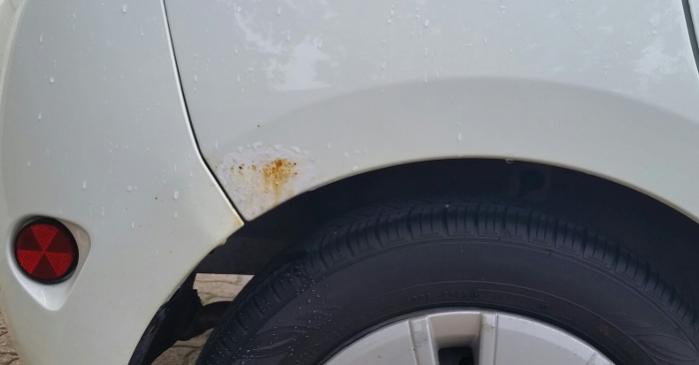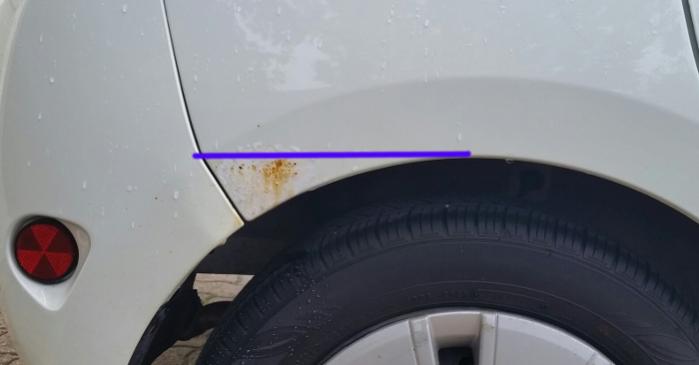 CSI: rear wheel arch rust. Seal these fasteners!
CSI: rear wheel arch rust. Seal these fasteners!

This is my third 2014 Mirage. All three of them had evidence of rusting from the inside out in this area (both sides), though this one is the worst by far.
I know other members are starting to see the same thing. (Obviously worse in locations that use salt on the roads or have salt in the air.)
I spent some time investigating how water is getting inside to cause this rust, and I think I know what's going on.
It's a water trap...

The area in question is a cavity formed between the outer wheel arch sheet metal and the inner wheel well structure, joined at the wheel arch flange. The gap between them where the rust happens is only about 4-5 mm, or 1/4 inch.
If & when water gets into this cavity, it can potentially fill up to the blue line before spilling forward, down the forward part of the wheel arch, and out the existing factory drain holes in the rocker panel structure.
But water below that line will just sit there, contributing to corrosion, until it eventually evaporates. Eventually, as with my car, corrosion will perforate the metal, blister the paint, and then the water can weep directly to the outside.
I suspect all Mirages that don't live in arid climates probably have water sitting in this cavity from time to time. If you also happen to live where there's salt in the air or on the roads, of course that's a bigger problem.
How is water getting inside?
First guess: I figured the problem was poor sealing or a gap somewhere along the wheel arch / wheel well flange that was letting in spray from the tire. But after repeatedly filling the inside of the wheel arch with water, watching for seepage, I couldn't find anything. The water only came out the rocker panel drains.
Second guess: there are four fasteners that penetrate the cavity from the outside that could potentially let moisture in.

Two (circled area on the right, fasteners not shown) are for attaching the bumper cover. The other two are behind the tail light assembly, to hold it in position on the body (one is shown by the arrow).
Primary suspect:

For some reason Mitsu put a foam gasket on this tail light locating fastener, but not on the other one.
Hmm! Do you think maybe they discovered water ingress was a problem here??
Sure enough, when I squirted around this fastener with low pressure, low volume water (squirt gun), some of it eventually wicked past the gasket to the inside of the cavity where it could drip and/or run straight down and replenish the swimming pool.
Note: the tail light does NOT sit flush against the body. Water running down or along the side of the car can easily reach that fastener.
I wonder how much water could seep in during an all day rain? Or at a high-pressure car wash? Or blasting down a wet, salt-soaked highway?
Solution...
Even though I think the top fastener is the most likely culprit (so did Mitsubishi, obviousy), I would seal around all four fastners with silicone.
Then I would get some anti-rust spray into that cavity (ideally when you know it's dry).
Accessing the cavity...

I didn't pull the left side cover, but the right side is accessible behind the side panel of the cargo compartment. You won't be able to get your fingers down into the narrow cavity to check for water. I used strips of paper towel to "dip" it dry.
Cold weather complication...

If you live where water freezes in the winter, it gets more complicated.
Water expands as it freezes, and the pressure may have caused the bead of sealant on the wheel arch flange to tear neatly along this line (frozen sealant won't flex under tension, it'll just break). Corrosion between the two sheets of metal would also put pressure on it.
Either way, that split has just created more opportunity for salty water to get in and accelerate the damage.
Q.E.D.!
__________________________________________
 View my fuel log 2014 Mirage ES 1.2 manual: 62.4 mpg (US) ... 26.5 km/L ... 3.8 L/100 km ... 74.9 mpg (Imp)
View my fuel log 2014 Mirage ES 1.2 manual: 62.4 mpg (US) ... 26.5 km/L ... 3.8 L/100 km ... 74.9 mpg (Imp)





 "Global Small" Concept
"Global Small" Concept Even Fancier Metro (Mirage #2)
Even Fancier Metro (Mirage #2) Fancy Metro (Mirage #1)
Fancy Metro (Mirage #1) Loaner #1 from Mitsubishi
Loaner #1 from Mitsubishi Loaner #2 from Mitsubishi
Loaner #2 from Mitsubishi Mirage #3: Appliance Car
Mirage #3: Appliance Car
 Reply With Quote
Reply With Quote